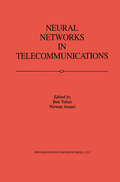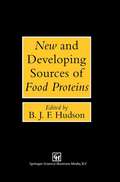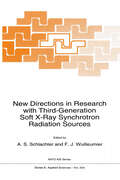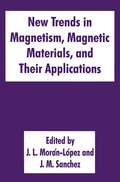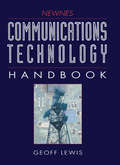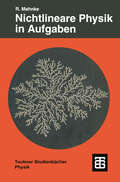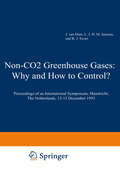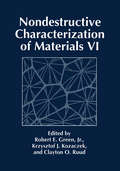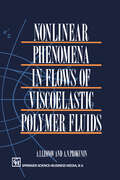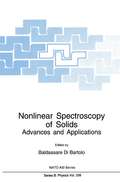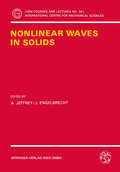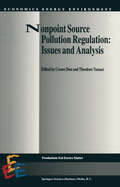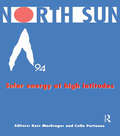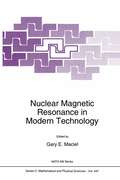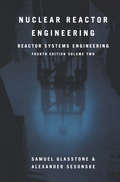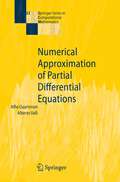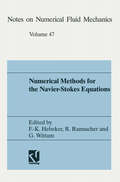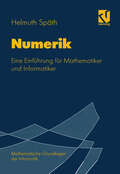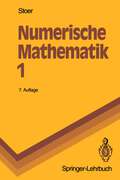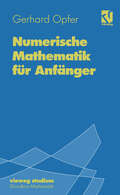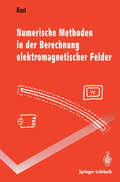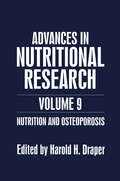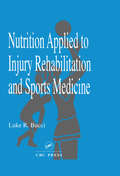- Table View
- List View
Neural Networks in Telecommunications
by Ben Yuhas Nirwan AnsariNeural Networks in Telecommunications consists of a carefully edited collection of chapters that provides an overview of a wide range of telecommunications tasks being addressed with neural networks. These tasks range from the design and control of the underlying transport network to the filtering, interpretation and manipulation of the transported media. The chapters focus on specific applications, describe specific solutions and demonstrate the benefits that neural networks can provide. By doing this, the authors demonstrate that neural networks should be another tool in the telecommunications engineer's toolbox. Neural networks offer the computational power of nonlinear techniques, while providing a natural path to efficient massively-parallel hardware implementations. In addition, the ability of neural networks to learn allows them to be used on problems where straightforward heuristic or rule-based solutions do not exist. Together these capabilities mean that neural networks offer unique solutions to problems in telecommunications. For engineers and managers in telecommunications, Neural Networks in Telecommunications provides a single point of access to the work being done by leading researchers in this field, and furnishes an in-depth description of neural network applications.
New and Developing Sources of Food Proteins
by B.J.F. HudsonThe recent series of texts 'Developments in Food Proteins' comprised in all seven volumes which were published in the course of the decade 1982-1991. Each volume contained inter alia one or more chapters that were concerned with new or developing sources of food proteins. Most of these have now been collected together in an up dated and re-evaluated form for the present volume. 'New' sources of food proteins includes those sources that are unconventional, that are still of very limited significance in market terms, or that are at present of very localized use. Several of these were included in 'Developments in Food Proteins'. One of them, algae, appeared both in Volume 1 and in an up-dated form in Volume 7. It is therefore not included here. Others, such as yeasts and bacteria, have not yet increased in practical importance as potential food components beyond the long-term promise already evident at that time. However, leaf protein, as described in the present Chapter 10, has moved from the original rather crude concept to a much more sophisticated product in the form of Rubisco. Fungal protein, as Quorn (Chapter 11), has also proved to be potentially of real food value. 'Developing' sources of food protein are those sources that have always been basic items in human diets.
New Directions in Research with Third-Generation Soft X-Ray Synchrotron Radiation Sources (NATO Science Series E: #254)
by A. S. Schlachter F. J. WuilleumierSoft X-rays are a powerful probe of matter. They interact selectively with electrons in atoms and molecules and can be used to study atomic physics, chemical reactions, surfaces and solids, and biological entities. Over the past 20 years, synchrotrons have emerged as powerful sources of soft X-rays for experimental use. A new, third generation of synchrotron light sources is scheduled to start operation over the next few years, beginning in 1993. These facilities are distinguished by their ultra-low emittance electron beams and by their undulators -- precisely engineered magnetic devices that cause the electrons passing through them to produce highly coherent X-rays and ultraviolet light of unprecedented spectral brightness. This volume emphasizes third-generation sources that produce light in the 10 eV--10 KeV energy range. It describes potential applications ranging from the purely scientific to the commercially viable and includes chapters on the practical aspects of designing undulators and beam line optics. Unique in its coverage, the book is a vital addition to the library of any scientist who needs information on the world's most advanced imaging and spectroscopic techniques. (ABSTRACT) This volume emphasizes the applications of new third generation synchrotron radiation sources that produce light in the ultraviolet and soft X-ray range of the spectrum. The unprecedented brightness of this light enables experiments to be conducted with greatly increased spatial and spectral resolution. Scientists can exploit these properties for imaging and spectroscopic applications that until now were impossible or impractical. Prominent researchers in the field describe these applications and others made possible by the light's pulsed time structure and polarization. The volume also includes chapters on the practical aspects of designing undulators and beam line optics.
New Trends in Magnetism, Magnetic Materials, and Their Applications
by J. L. Morán-López José M. SánchezDuring August 24-27, 1993, approximately 60 scientists from the Americas, Europe and Japan, gathered in the city of Guanajuato, in the state of Guanajuato, Mexico, at the II Latin American Workshop on Magnetism, Magnetic Materials and their Applications. The group of scientists converging into the beautiful city of Guanajuato had come from Argentina, Chile, Brazil, Venezuela, Cuba, several places in Mexico, U. S. A. , Japan, Spain, France, Italy, Germany, Austria, Switzerland, and Denmark. The event attested to the success of the previous Workshop on Magnetism, Magnetic Materials and their Applications, held in Havana, Cuba, in 1991, as well as to the interest, level of activity and quality of the work being carried out in Latin America in the area of magnetism and magnetic materials. Equally important to everyone present was the fact that we had come to honor a friend, Professor L. M. Falicov, on his sixtieth birthday. The choice of a Latin American Workshop on magnetism as a Festschrift for Leo Falicov was, in our opinion, quite appropriate not only because of Leo's strong ties to Latin America, but also because of his superb contributions to science, and in particular, to magnetism. Professor Falicov was born in Buenos Aires, Argentina, where he spent a good part of his formative years.
Newnes Communications Technology Handbook
by Geoff LewisNewnes Communications Technology Handbook provides a discussion on different topics relevant to communications technology. The book is comprised of 39 chapters that tackle a wide variety of concern in communications technology. The coverage of the text includes technologies, such as analog digital communications systems, radio frequency receiver, and satellite systems. The book also discusses some methods and techniques used in communications technology, including mixer signal processing, modulation and demodulation, and spread spectrum techniques. The text will be of great use to engineers, technicians, and professionals involved in telecommunications.
Non-CO2 Greenhouse Gases: Proceedings of an International Symposium, Maastricht, The Netherlands, 13–15 December 1993
by J. Van Ham H. M. L. Janssen Rob J. SwartThe background This volume contains the proceedings of the first International symposium on "Non-C0 Greenhouse Gases: Why and How to 2 Control?" held in Maastricht, The Netherlands from 13-15 Decem ber 1993. Of the known greenhouse gases, political attention to date has been primarily focused on carbon dioxide (C0 ) and the 2 CFCs - the latter because of their interaction with stratospheric ozone. The other greenhouse gases, notably methane (CH ), nitrous 4 oxide (N 0), HCFCs, HFCs and tropospheric ozone and its precur 2 sors nitrogen oxides (NO), carbon monoxide (CO) and volatile organic compounds (VOCs), may appear collectively to be of equal importance for global warming but have attracted less attention. Nevertheless, a comprehensive approach to climate change respon se, taking into account all sources and sinks of all greenhouse gases, is explicitly allowed in the Framework Convention on Clima te Change. The Netherlands' policy on climate already addresses all greenhouse gases. In order to stimulate the development of international climate policy on this subject, the Dutch Ministry of Housing, Physical Planning and Environment supported the initative of organizing an international symposium on the science and policy of the non-C0 greenhouse gases. An important rationale behind 2 this initative was recognizing that for the non-C0 greenhouse 2 gases, abatement options are available that do not only address other environmental problems but that also do not require the major structural changes in society that an effective CO policy 2 may.
Nondestructive Characterization of Materials VI
by Robert E. Green K. J. Kozaczek C. O. RuudTraditionally the vast majority of materials characterization techniques have been destructive, e. g. , chemical compositional analysis, metallographic determination of microstructure, tensile test measurement of mechanical properties, etc. Also, traditionally, nondestructive techniques have been used almost exclusively for the detection of macroscopic defects, mostly cracks, in structures and devices which have already been constructed and have already been in service for an extended period of time. Following these conventional nondestructive tests, it has been common practice to use somewhat arbitrary accept-reject criteria to decide whether or not the structure or device should be removed from service. The present unfavorable status of a large segment of industry, coupled with the desire to keep structures in service well past their original design life, dramatically show that our traditional approaches must be drastically modified if we are to be able to meet future needs. The role of nondestructive characterization of materials is changing and will continue to change dramatically. It has become increasingly evident that it is both practical and cost effective to expand the role of nondestructive evaluation to include all aspects of materials' production and application and to introduce it much earlier in the manufacturing cycle. In fact, the recovery of a large portion of industry from severe economic problems is dependent, in part, on the successful implementation of this expanded role.
Nonlinear Phenomena in Flows of Viscoelastic Polymer Fluids
by A.I. Leonov A.N. ProkuninThis monograph presents theoretical and experimental studies of flows of elastic liquids. Falling into this category are particularly the melts and concentrated solutions of such flexible-chain polymers as polyethylene, polyisobutylene and polypropylene, all of which are widely used in polymer processing. These polydisperse polymers vary greatly, from batch to batch, in their mechanical properties and 20% variation in a property is believed to be good enough. l 7 All recent books - devoted to the rheology of polymers do not answer the question of which constitutive equations should be used for solving the fluid mechanic problems of polymer processing in the usual case of an appreciable nonlinear region of deformation where nonlinear effects of shear and extensional elasticity are very important. Viscoelastic constitut ive equations cited commonly (see, e.g. Refs 5 and 6) do not describe simultaneously even the simplest cases of deformations, viz. simple shear and uniaxial extension. Moreover, some of them are internally inconsist ent and sometimes display highly unstable behaviour in simple flows without any fundamental reasons. Even more respected molecular ap free from these defects.
Nonlinear Spectroscopy of Solids: Advances and Applications (Nato Science Series B: #339)
by Brian BowlbyThis report presents an account of the course "Nonlinear Spectroscopy of Solids: Advances and Applications" held in Erice, Italy, from June 16 to 30, 1993. This meeting was organized by the International School of Atomic and Molecular Spectroscopy of the "Ettore Majorana" Centre for Scientific Culture. The purpose of this course was to present and discuss physical models, mathematical formalisms, experimental techniques, and applications relevant to the subject of nonlinear spectroscopy of solid state materials. The universal availability and application of lasers in spectroscopy has led to the widespread observation of nonlinear effects in the spectroscopy of materials. Nonlinear spectroscopy encompasses many physical phenomena which have their origin in the monochromaticity, spectral brightness, coherence, power density and tunability of laser sources. Conventional spectroscopy assumes a linear dependence between the applied electromagnetic field and the induced polarization of atoms and molecules. The validity of this assumption rests on the fact that even the most powerful conventional sources of light produce a light intensity which is not strong enough to equalize the rate of stimulated emission and that of the experimentally observed decay. A different situation may arise when laser light sources are used, particularly pulsed lasers. The use of such light sources can make the probability of induced emission comparable to, or even greater than, the probability of the observed decay; in such cases the nonlinearity of the response of the system is revealed by the experimental data and new properties, not detectable by conventional spectroscopy, will emerge.
Nonlinear Waves in Solids (CISM International Centre for Mechanical Sciences #341)
by A. Jeffrey J. EngelbrechtTravelling wave processes and wave motion are of great importance in many areas of mechanics, and nonlinearity also plays a decisive role there. The basic mathematical models in this area involve nonlinear partial differential equations, and predictability of behaviour of wave phenomena is of great importance. Beside fluid dynamics and gas dynamics, which have long been the traditional nonlinear scienes, solid mechanics is now taking an ever increasing account of nonlinear effects. Apart from plasticity and fracture mechanics, nonlinear elastic waves have been shown to be of great importance in many areas, such as the study of impact, nondestructive testing and seismology. These lectures offer a thorough account of the fundamental theory of nonlinear deformation waves, and in the process offer an up to date account of the current state of research in the theory and practice of nonlinear waves in solids.
Nonpoint Source Pollution Regulation: Issues and Analysis (Economics, Energy and Environment #3)
by Cesare Dosi Theodore TomasiIn April 1992 the Foundation Eni Enrico Mattei organized a workshop on the regulation of nonpoint source pollution. This volume inc1udes the proceedings of that meeting, as well as additional original contributions, in an attempt to provide an overview of recent theoretical developments in the field. Research on the causes, consequences, and control of nonpoint source pol lution has been carried out over the last two decades. Interest in this subject has grown as a result of the increasing recognition of the insufficiency of traditional pollution control policies focused on the large scale, confined, and general ly predictable pollutant discharges. In fact, many contemporary problems are caused by the combined activities of small polluters, along with natural pro cesses, intermittent and unpredictable events, and often involve pollutants with complex environmental outcomes. Despite the progress made in understanding the nature and size of pollution from diffuse sources, the issue of regulation is still far from being system at ically and adequately addressed. This policy vacuum is partly attributable to the difficulty of adapting the traditional point source regulatory tool kit to the specific features of nonpoint source problems. Such features inc1ude the tech nical difficulty of identifying sources and measuring individual emissions, their variability over time and space, the role played by natural processes in detennin ing pollutant discharges at source and their ultimate impacts on the receiving environmental media.
North Sun '94: Solar Energy at High Latitudes
by Kerr McGregorFirst Published in 1994. Routledge is an imprint of Taylor & Francis, an informa company.
North Sun '94: Solar Energy at High Latitudes
by Kerr McGregorFirst Published in 1994. Routledge is an imprint of Taylor & Francis, an informa company.
Nuclear Magnetic Resonance in Modern Technology (Nato Science Series C: #447)
by G. E. MacielThis volume represents the primary lectures of the NATO Advanced Study Institute (ASI) on "Nuclear Magnetic Resonance in Modern Technology," which was held at Sarigerme Park (near the Dalaman Airport) on the southern Aegean shore of Turkey from August 23 to September 4, 1992. As indicated in the title, this ASI was aimed at examining, displaying, and perhaps influencing, the role of nuclear magnetic resonance (NMR) in modern technological activity. The lectures summarized in this volume and the numerous short contributed talks and posters were primarily aimed at the question, "What is NMR doing in support of modern technology?" During the main discussion periods and the numerous small scheduled meetings of specific interest groups this same topic was also addressed, along with questions like, "What could or should NMR be doing in support of modern technology?" With this kind of subject orientation, the organizers attempted to include a large participation at the ASI from scientists and engineers from diverse private industries in which NMR does, or perhaps should, play a substantial role in supporting or optimizing technology. Perhaps because of a combination of worldwide industrial contractions and residual corporate nervousness regarding the then recent Gulf War (which caused a one-year postponement of this ASI), the participation from private industry was numerically disappointing. We hope that this book will serve to bring the role of NMR in modern industry to the attention of numerous industrial scientists and engineers who were unable to attend the AS!.
Nuclear Reactor Engineering: Reactor Systems Engineering
by Samuel Glasstone Alexander SesonskeDr. Samuel Glasstone, the senior author of the previous editions of this book, was anxious to live until his ninetieth birthday, but passed away in 1986, a few months short of this milestone. I am grateful for the many years of stimulation received during our association, and in preparing this edition have attempted to maintain his approach. Previous editions of this book were intended to serve as a text for students and a reference for practicing engineers. Emphasis was given to the broad perspective, particularly for topics important to reactor design and oper ation, with basic coverage provided in such supporting areas as neutronics, thermal-hydraulics, and materials. This, the Fourth Edition, was prepared with these same general objectives in mind. However, during the past three decades, the nuclear industry and university educational programs have matured considerably, presenting some challenges in meeting the objec tives of this book. Nuclear power reactors have become much more complex, with an ac companying growth in supporting technology. University programs now offer separate courses covering such basic topics as reactor physics, thermal hydraulics, and materials. Finally, the general availability of inexpensive xv xvi Preface powerful micro-and minicomputers has transformed design and analysis procedures so that sophisticated methods are now commonly used instead of earlier, more approximate approaches.
Numerical Approximation of Partial Differential Equations (Springer Series in Computational Mathematics #23)
by Alfio Quarteroni Alberto ValliEverything is more simple than one thinks but at the same time more complex than one can understand Johann Wolfgang von Goethe To reach the point that is unknown to you, you must take the road that is unknown to you St. John of the Cross This is a book on the numerical approximation ofpartial differential equations (PDEs). Its scope is to provide a thorough illustration of numerical methods (especially those stemming from the variational formulation of PDEs), carry out their stability and convergence analysis, derive error bounds, and discuss the algorithmic aspects relative to their implementation. A sound balancing of theoretical analysis, description of algorithms and discussion of applications is our primary concern. Many kinds of problems are addressed: linear and nonlinear, steady and time-dependent, having either smooth or non-smooth solutions. Besides model equations, we consider a number of (initial-) boundary value problems of interest in several fields of applications. Part I is devoted to the description and analysis of general numerical methods for the discretization of partial differential equations. A comprehensive theory of Galerkin methods and its variants (Petrov Galerkin and generalized Galerkin), as wellas ofcollocationmethods, is devel oped for the spatial discretization. This theory is then specified to two numer ical subspace realizations of remarkable interest: the finite element method (conforming, non-conforming, mixed, hybrid) and the spectral method (Leg endre and Chebyshev expansion).
Numerical methods for the Navier-Stokes equations: Proceedings of the International Workshop Held at Heidelberg, October 25–28, 1993 (Notes on Numerical Fluid Mechanics and Multidisciplinary Design #47)
by Friedrich-Karl HebekerNumerik: Eine Einführung für Mathematiker und Informatiker (Mathematische Grundlagen der Informatik)
by Helmuth SpäthDas Buch bietet Mathematikern und Informatikern gleichermaßen eine geeignete Einführung in die Numerik, die den Anforderungen der gängigen Grundvorlesungen entspricht. Dabei ist es einerseits wesentliches Ziel, die Konstruktion von Algorithmen und deren computergerechte Umsetzung in Programme zu vermitteln. Andererseits wird durch die Stoffauswahl sichergestellt, daß sowohl Hauptfach- wie auch Nebenfachstudenten eine solide Basis auch für weiterführende Vorlesungen erhalten. Das Buch entstand auf der Grundlage von Vorlesungen, die an der Universität Oldenburg gehalten wurden. Das Buch ist das erste einer Reihe, die sowohl von Mathematikern wie auch Informatikern herausgegeben wird und es sich zum Ziel gesetzt hat, der Neubewertung von Mathematik, gehalten in beiden Fächern, Rechnung zu tragen. Zum einen sollten Mathematiker mit besonderem Interesse für die Anwendungen der Informatik ihr spezifisches Fachwissen einbringen. Zum anderen sollen Informatiker ihre Erfahrungen einfließen lassen, die die Darstellung und Auswahl des Stoffes aus der Sicht der Informatik betreffen. Ganz bewußt ist dieses Buch wie auch die anderen Bände der Reihe von überschaubarem Umfang - last not least mit dem Vorteil eines entsprechend günstigen Ladenpreises.
Numerische Mathematik 1: Eine Einführung — unter Berücksichtigung von Vorlesungen von F. L. Bauer (Springer-Lehrbuch)
by Josef StoerAus den Besprechungen: "Diese Einführung zeichnet sich durch eine klare, gut lesbare Darstellung aus und ist eine gelungene Synthese zwischen theoretischer Begründung und praktischer Anwendung der behandelten Methoden. Deshalb ist sie auch zu einem Standardlehrbuch der Numerischen Mathematik geworden." #Internationale Mathematische Nachrichten#1 "Unter den Numerik-Lehrbüchern ... sei auf das vorliegende Buch besonders hingewiesen, da hier bei allen Ansprüchen an mathematische Strenge das Schwergewicht auf die Bereitstellung von praktikablen Algorithmen nach neuesten Erkenntnissen mit vielen numerischen Beispielen und kritischen Beurteilungen liegt..."#Die neue Hochschule#
Numerische Mathematik für Anfänger (vieweg studium; Grundkurs Mathematik)
by Gerhard OpferDieses Buch will dem Studienanfänger einen Einstieg in die Numerische Mathematik bieten, eine Disziplin, die früher ausschließlich im Hauptstudium angeboten wurde, inzwischen aber an mehreren Universitäten sinnvollerweise bereits im ersten Semester auf dem Lehrplan steht. Gerhard Opfer hat dafür ein Buch zur Einführung verfaßt, das auf einem in vielen Semestern sorgfältig überprüften neuen Konzept beruht. Es trägt den Besonderheiten des Fachs mit vielen Beispielen und Aufgaben Rechnung. Der Student lernt, den Stoff selbständig zu erarbeiten und zu vertiefen. Er wird bald einen Blick für mögliche Reduzierungen des Aufwandes, den ein Algorithmus verursacht, für die notwendige Stabilität, die den immer auftretenden Rundungsfehlern Schranken setzt, und für vorhandene, aber noch nicht genutzte Parallelisierungen, die Rechenzeit sparen helfen, entwickeln.
Numerische Methoden in der Berechnung elektromagnetischer Felder (Springer-Lehrbuch)
by Arnulf KostDie Konstruktion von elektrotechnischen Bauelementen, Baugruppen und Anlagen ist ohne die numerische Feldberechnung nicht mehr denkbar. Da es keine für alle Problemstellungen gleichermaßen geeignete Methode gibt, werden die wichtigsten numerischen Methoden vergleichend behandelt und ihre gemeinsamen Wurzeln sichtbar gemacht. Besonders eingegangen wird dabei auf die Methode der Finiten Elemente (FEM), die Boundary Element Methode (BEM) und die aus beiden bestehende Kopplungsmethode (BEM/FEM). Anhand praktischer Beispiele aus Energie- und Nachrichtentechnik, der Mikroelektronik und der elektromagnetischen Verträglicheit werden gleichzeitig die durch die Methoden bedingten besonderen Erfordernisse (z.B. Fehlerschätzung, Adaptive Netzgenerierung etc.) erörtert.
Nutrition and Osteoporosis (Advances in Nutritional Research #9)
by Harold H. DraperNutrition and Osteoporosis: Seeing Through a Glass, Darkly (1 Cor. 13:12) This volume of Advances in Nutritional Research deals with the present state of knowledge relative to the role of nutrition in the etiology of osteoporosis, one of the most serious degenerative diseases in the aging population. As a back drop for subsequent chapters on specific nutrients, Chapter 1 provides a com prehensive account of the gain and loss of bone throughout the life cycle, with emphasis on the architectural changes in later life that predispose to osteoporotic bone fractures. Chapter 2 documents the occurrence of aging bone loss through out human archeological history and Chapter 3 extends this documentation to all non-human vertebrate species so far examined, including primates living in the wild. It is apparent that a progressive loss of bone tissue is a normal accompaniment of aging among higher vertebrates. Whether it is a cause of bone fractures in animals, as it is in humans, is still unknown. It has also been established that there are significant differences in the frequency of osteoporotic fractures among human families, ethnic groups, national populations and diet cultures. Numerous studies have been carried out in an effort to explain these differences, and many of these deal with the possible effect of nutrition. Protracted controversies over the role of nutrition in the etiology of osteoporosis are reflected in the contents of several of the ensuing chapters.
Nutrition Applied to Injury Rehabilitation and Sports Medicine (Nutrition In Exercise And Sport Ser.)
by Luke R. BucciThis timely and exciting new book brings together for the first time the readily available choices of dietary supplements and their relationship to injury rehabilitation. Nutrition Applied to Injury Rehabilitation and Sports Medicine supports the rational use of specific nutrients for specific healing conditions. Guidelines for nutritional programs applied to specific conditions are provided for practical application.
Nutrition Applied to Injury Rehabilitation and Sports Medicine (Nutrition In Exercise And Sport Ser. #4)
by Luke R. BucciThis timely and exciting new book brings together for the first time the readily available choices of dietary supplements and their relationship to injury rehabilitation. Nutrition Applied to Injury Rehabilitation and Sports Medicine supports the rational use of specific nutrients for specific healing conditions. Guidelines for nutritional programs applied to specific conditions are provided for practical application.
